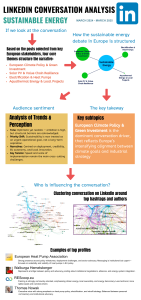Unlock the power of LinkedIn: how data-driven insights on LinkedIn can shape European Policy and industry trends
26 de February de 2025Who’s Driving the Tariff Conversation on Bluesky?
14 de April de 2025Our LinkedIn listening study reveals the key voices and narratives.
At Sybaris, our agency has been closely monitoring how the conversation around Sustainable Energy has evolved on LinkedIn over the past year — and the findings are powerful. Through a social listening analysis focused on the Brussels Bubble and key voices across Europe, we’ve identified the top themes, influencers, and narratives driving this critical debate.
This isn’t just data. It’s insight — designed to help businesses, institutions and advocacy groups better understand where the conversation is heading, and how to position themselves within it.
What’s Being Said — and Why It Matters
As part of our study, we built a visual network graph (included in the infographic) using LinkedIn data to map out the most active authors in the sustainable energy conversation, and how they connect to the top hashtags shaping the dialogue.
What does this tell us?
It’s not just about who posts the most — it’s about who’s best connected across different topics. In our network graph, we can see how authors and hashtags interact, revealing not just influence, but also which voices are bridging different parts of the conversation, from policy to innovation to community action.
Unsurprisingly, #Sustainability is the most widely used hashtag, followed by #EnergyTransition, #RenewableEnergy, and #CleanEnergy — all key pillars in Europe’s ongoing energy dialogue.
Four major themes emerged our research:
1. Climate Policy & Green Investment: The most discussed topic, focused on aligning climate goals with industrial strategy. Posts highlight EU initiatives like the Green Deal and Net-Zero Industry Act, but also express concern over slow regulation and policy clarity.
2. Solar PV & Value Chain Resilience: Discussions stress the need to strengthen Europe’s solar manufacturing and reduce dependency on non-EU suppliers. The emphasis is on building a resilient, autonomous value chain.
3. Electrification & Heat Pumps: A practical, solution-focused theme centred on deploying heat pumps and boosting energy efficiency. While momentum is growing, challenges such as cost, skills gaps, and permitting still slow progress.
4. Aquathermal Energy & Local Projects: A smaller but emerging theme highlighting local, community-led energy solutions. These projects are seen as promising models for a just, decentralised transition — though still in need of stronger institutional backing.
Across all topics, the tone is urgent but optimistic. Stakeholders are calling for faster deployment, better regulation, and proof of impact — not just promises. There’s also growing emphasis on strategic autonomy and local innovation, highlighting Europe’s ambition to lead on climate while staying economically resilient.
Who’s Influencing the Debate?
Using a combination of network analysis and a scatter plot in a Cartesian representation of each author’s number of followers and posts, we mapped the most active LinkedIn contributors and the key hashtags shaping the narrative.
- #Sustainability, #EnergyTransition, and #RenewableEnergy are the most connected hashtags.
- Influential voices include: European Heat Pump Association, Walburga Hemetsberger, REScoop.eu and Thomas Nowak— all bridging multiple themes and sectors.
These actors are central not only because of their reach, but because they link policy, media, and innovation narratives — making them strategic multipliers for any campaign.
What We Offer
Our study goes beyond surface metrics. We provide:
- Keyword and hashtag summaries
- Author profiling (tone, themes, influence)
- Actionable insights for targeting and outreach
- Custom reports for clients looking to shape or enter the conversation
📩 Want to know how your organisation can stand out in the EU energy dialogue?
Let’s talk. We’ll help you connect with the people and narratives that matter most.

